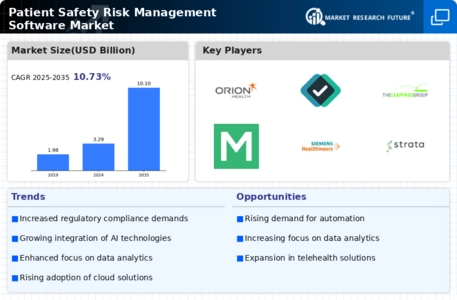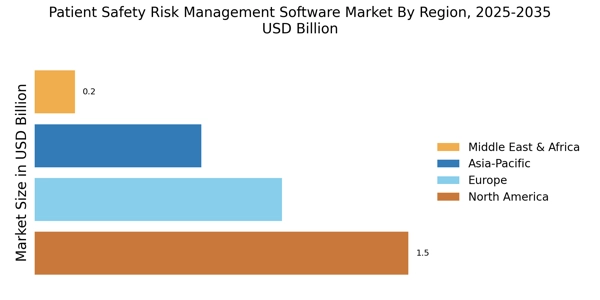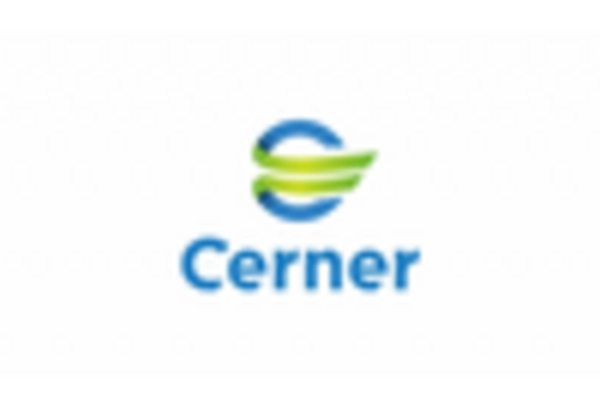Focus on User-Centric Design
The emphasis on user-centric design is emerging as a significant driver for the Patient Safety Risk Management Software Market. As healthcare professionals increasingly demand intuitive and user-friendly interfaces, software developers are prioritizing design elements that enhance usability. This shift is crucial, as complex systems can lead to user errors, potentially compromising patient safety. By focusing on user experience, software solutions can facilitate better adoption rates among healthcare staff, ultimately leading to improved patient outcomes. The market is witnessing a trend where organizations are investing in software that not only meets functional requirements but also aligns with the needs of its users. This focus on design is likely to shape the future of patient safety software, making it a key consideration for stakeholders.
Growing Awareness of Patient Safety
The growing awareness of patient safety issues is a fundamental driver for the Patient Safety Risk Management Software Market. As healthcare providers and patients alike become more cognizant of the risks associated with medical care, there is an increasing demand for solutions that can mitigate these risks. Educational initiatives and advocacy for patient safety have led to a cultural shift within healthcare organizations, prompting them to prioritize risk management strategies. This heightened awareness is reflected in the rising investments in software solutions designed to enhance patient safety protocols. Furthermore, studies indicate that organizations that implement effective risk management systems experience lower rates of adverse events, reinforcing the need for such software. As awareness continues to grow, the market for patient safety risk management software is expected to expand significantly.
Regulatory Compliance and Standards
Regulatory compliance and adherence to safety standards are critical drivers for the Patient Safety Risk Management Software Market. Healthcare organizations are mandated to comply with various regulations, such as those set forth by health authorities and accreditation bodies. These regulations often require the implementation of risk management systems to ensure patient safety and quality of care. The increasing scrutiny from regulatory agencies has led to a heightened focus on risk management solutions that can demonstrate compliance effectively. As a result, the market for patient safety software is expected to expand, with organizations seeking tools that not only meet regulatory requirements but also enhance overall operational efficiency. The financial implications of non-compliance can be severe, further incentivizing healthcare providers to invest in robust risk management software.
Integration of Advanced Technologies
The integration of advanced technologies such as artificial intelligence and machine learning is a pivotal driver for the Patient Safety Risk Management Software Market. These technologies enhance the ability to analyze vast amounts of data, thereby identifying potential risks more effectively. For instance, predictive analytics can forecast adverse events, allowing healthcare providers to implement preventive measures proactively. The market for AI in healthcare is projected to reach substantial figures, indicating a growing reliance on technology to improve patient safety. Furthermore, the incorporation of real-time monitoring systems enables immediate responses to safety concerns, which is crucial in high-stakes environments. As healthcare organizations increasingly adopt these technologies, the demand for sophisticated risk management software is likely to rise, further propelling the market forward.
Increased Investment in Healthcare IT
Increased investment in healthcare IT infrastructure is a crucial driver for the Patient Safety Risk Management Software Market. As healthcare organizations recognize the importance of technology in improving patient outcomes, there is a marked shift towards investing in comprehensive IT solutions. This trend is evidenced by the rising budgets allocated for health information technology, which includes patient safety software. The integration of electronic health records and other digital tools facilitates better data sharing and communication among healthcare providers, thereby enhancing risk management capabilities. Moreover, the ongoing digital transformation in healthcare is likely to create new opportunities for software vendors, as organizations seek innovative solutions to address patient safety challenges. This influx of investment is expected to bolster the market, driving the development of more sophisticated risk management software.


















Leave a Comment